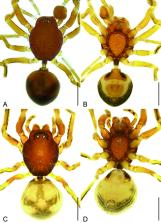We present a phylogenetic analysis of spiders using a dataset of 932 spider species, representing 115 families (only the family Synaphridae is unrepresented), 700 known genera, and additional representatives of 26 unidentified or undescribed genera. Eleven genera of the orders Amblypygi, Palpigradi, Schizomida and Uropygi are included as outgroups. The dataset includes six markers from the mitochondrial (12S, 16S, COI) and nuclear (histone H3, 18S, 28S) genomes, and was analysed by multiple methods, including constrained analyses using a highly supported backbone tree from transcriptomic data. We recover most of the higher-level structure of the spider tree with good support, including Mesothelae, Opisthothelae, Mygalomorphae and Araneomorphae. Several of our analyses recover Hypochilidae and Filistatidae as sister groups, as suggested by previous transcriptomic analyses. The Synspermiata are robustly supported, and the families Trogloraptoridae and Caponiidae are found as sister to the Dysderoidea. Our results support the Lost Tracheae clade, including Pholcidae, Tetrablemmidae, Diguetidae, Plectreuridae and the family Pacullidae (restored status) separate from Tetrablemmidae. The Scytodoidea include Ochyroceratidae along with Sicariidae, Scytodidae, Drymusidae and Periegopidae; our results are inconclusive about the separation of these last two families. We did not recover monophyletic Austrochiloidea and Leptonetidae, but our data suggest that both groups are more closely related to the Cylindrical Gland Spigot clade rather than to Synspermiata. Palpimanoidea is not recovered by our analyses, but also not strongly contradicted. We find support for Entelegynae and Oecobioidea (Oecobiidae plus Hersiliidae), and ambiguous placement of cribellate orb-weavers, compatible with their non-monophyly. Nicodamoidea (Nicodamidae plus Megadictynidae) and Araneoidea composition and relationships are consistent with recent analyses. We did not obtain resolution for the titanoecoids (Titanoecidae and Phyxelididae), but the Retrolateral Tibial Apophysis clade is well supported. Penestomidae, and probably Homalonychidae, are part of Zodarioidea, although the latter family was set apart by recent transcriptomic analyses. Our data support a large group that we call the marronoid clade (including the families Amaurobiidae, Desidae, Dictynidae, Hahniidae, Stiphidiidae, Agelenidae and Toxopidae). The circumscription of most marronoid families is redefined here. Amaurobiidae include the Amaurobiinae and provisionally Macrobuninae. We transfer Malenellinae (Malenella, from Anyphaenidae), Chummidae (Chumma) (new syn.) and Tasmarubriinae (Tasmarubrius, Tasmabrochus and Teeatta, from Amphinectidae) to Macrobuninae. Cybaeidae are redefined to include Calymmaria, Cryphoeca, Ethobuella and Willisius (transferred from Hahniidae), and Blabomma and Yorima (transferred from Dictynidae). Cycloctenidae are redefined to include Orepukia (transferred from Agelenidae) and Pakeha and Paravoca (transferred from Amaurobiidae). Desidae are redefined to include five subfamilies: Amphinectinae, with Amphinecta, Mamoea, Maniho, Paramamoea and Rangitata (transferred from Amphinectidae); Ischaleinae, with Bakala and Manjala (transferred from Amaurobiidae) and Ischalea (transferred from Stiphidiidae); Metaltellinae, with Austmusia, Buyina, Calacadia, Cunnawarra, Jalkaraburra, Keera, Magua, Metaltella, Penaoola and Quemusia; Porteriinae (new rank), with Baiami, Cambridgea, Corasoides and Nanocambridgea (transferred from Stiphidiidae); and Desinae, with Desis, and provisionally Poaka (transferred from Amaurobiidae) and Barahna (transferred from Stiphidiidae). Argyroneta is transferred from Cybaeidae to Dictynidae. Cicurina is transferred from Dictynidae to Hahniidae. The genera Neoramia (from Agelenidae) and Aorangia, Marplesia and Neolana (from Amphinectidae) are transferred to Stiphidiidae. The family Toxopidae (restored status) includes two subfamilies: Myroinae, with Gasparia, Gohia, Hulua, Neomyro, Myro, Ommatauxesis and Otagoa (transferred from Desidae); and Toxopinae, with Midgee and Jamara, formerly Midgeeinae, new syn. (transferred from Amaurobiidae) and Hapona, Laestrygones, Lamina, Toxops and Toxopsoides (transferred from Desidae). We obtain a monophyletic Oval Calamistrum clade and Dionycha; Sparassidae, however, are not dionychans, but probably the sister group of those two clades. The composition of the Oval Calamistrum clade is confirmed (including Zoropsidae, Udubidae, Ctenidae, Oxyopidae, Senoculidae, Pisauridae, Trechaleidae, Lycosidae, Psechridae and Thomisidae), affirming previous findings on the uncertain relationships of the "ctenids" Ancylometes and Cupiennius, although a core group of Ctenidae are well supported. Our data were ambiguous as to the monophyly of Oxyopidae. In Dionycha, we found a first split of core Prodidomidae, excluding the Australian Molycriinae, which fall distantly from core prodidomids, among gnaphosoids. The rest of the dionychans form two main groups, Dionycha part A and part B. The former includes much of the Oblique Median Tapetum clade (Trochanteriidae, Gnaphosidae, Gallieniellidae, Phrurolithidae, Trachelidae, Gnaphosidae, Ammoxenidae, Lamponidae and the Molycriinae), and also Anyphaenidae and Clubionidae. Orthobula is transferred from Phrurolithidae to Trachelidae. Our data did not allow for complete resolution for the gnaphosoid families. Dionycha part B includes the families Salticidae, Eutichuridae, Miturgidae, Philodromidae, Viridasiidae, Selenopidae, Corinnidae and Xenoctenidae (new fam., including Xenoctenus, Paravulsor and Odo, transferred from Miturgidae, as well as Incasoctenus from Ctenidae). We confirm the inclusion of Zora (formerly Zoridae) within Miturgidae.
